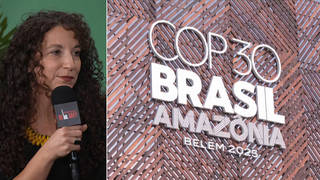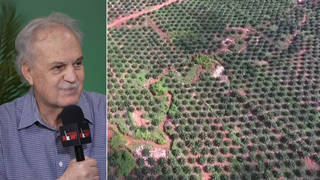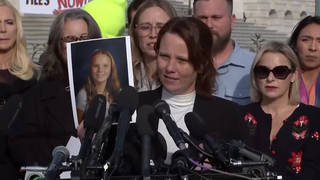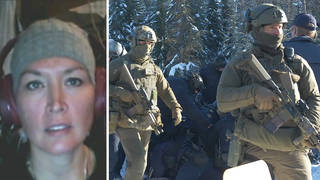
Guests
- Brandi MorinCree/Iroquois/French journalist.
- David Wallace-Wellsauthor and New York Times opinion writer.
Record-breaking Canadian wildfires continue to fill skies across much of North America with smoke, putting about 100 million people under air quality alerts. New York City recorded the worst air quality of any major city in the world as a result of the haze. Around the world, air pollution is already responsible for as many as 10 million deaths per year, and the problem is likely to get worse, says New York Times opinion writer David Wallace-Wells. He explains how today’s smoky skies are a glimpse of our future in the climate crisis, when warmer temperatures and dry conditions will continue to increase the size and severity of wildfires across the globe. “It’s not just that we’re getting more fires, and it’s not even that they’re getting larger. They’re also getting much more intense, which means that they are cooking much of the landscape,” says Wallace-Wells, author of The Uninhabitable Earth: Life After Warming. We also hear from Cree/Iroquois/French journalist Brandi Morin, who just returned from reporting on the wildfires raging in the remote Indigenous community of Fort Chipewyan in Canada’s North, which she calls the “epicenter of the effects of climate change because it’s downstream from one of the largest oil production developments in the world, Alberta’s oil sands.”
Transcript
AMY GOODMAN: This is Democracy Now!, democracynow.org, The War and Peace Report. I’m Amy Goodman in New York, joined by Democracy Now! co-host Nermeen Shaikh. Hi, Nermeen.
NERMEEN SHAIKH: Hi, Amy, and welcome to our listeners and viewers across the country and around the world.
AMY GOODMAN: It’s good to see you here in the studio. If we were outside, here in New York, it would be a bit more difficult.
Over 90 million people across large swaths of the United States and Canada woke up to hazy skies and air quality alerts for a third straight day today as thick smoke from Canadian wildfires continues to blanket areas as far west as Kansas, as far south as the Carolinas. Here in New York City, the sky turned orange Wednesday as the city’s air became the most polluted in the world. New York Governor Kathy Hochul called the situation “an emergency crisis.”
GOV. KATHY HOCHUL: It has an immediate impact on people’s health: irritation to the eyes, the nose, breathing, coughing, so — and even shortness of breath. So, our message right now is going to be reiterated multiple times, because it is simply stay indoors.
AMY GOODMAN: As people were urged to stay inside, delivery workers took to social media to share pictures of themselves still working in the extreme conditions. A number of schools have closed due to the smoke, along with public parks. Hospital emergency rooms reported an increase in patients with respiratory issues. Flights were grounded at airports in the Northeast. Health experts are advising people who need to be outdoors to wear an N95 mask if possible, to block out the dangerous fine particulate matter from the smoke. Forecasters expect the smoke to move south and west later today.
Climate scientists say this comes amidst a steep increase in wildfires during the 21st century due to hotter temperatures and drier conditions created by climate change.
Meanwhile, to the north, in Canada, many of the fires generating the smoke continue to burn out of control. This is Canadian Federal Minister of Emergency Preparedness Bill Blair speaking Wednesday.
BILL BLAIR: As of today, there are 2,293 wildfires that have occurred in Canada. Approximately 3.8 million hectares have been burned. And across the country, as of today, there are 414 wildfires burning, 239 of which are determined to be out of control. Also as of today, an estimated 20,183 people remain evacuated from their homes and communities.
AMY GOODMAN: Also on Wednesday, Democracy Now! spoke to Brandi Morin, a Cree/Iroquois/French journalist based in Alberta, Canada, after she returned from reporting on the wildfires raging in the remote Indigenous community of Fort Chipewyan.
BRANDI MORIN: I was in the northern part of Alberta in a remote Indigenous community of Fort Chipewyan that has been evacuated. It’s only accessible by boat or plane. And the fire is encroaching on their community. It’s about seven kilometers away. It’s nearly 25,000 hectares. It’s massive.
But what is significant about this community is that it is the epicenter of the effects of climate change because it’s downstream from one of the largest oil production developments in the world, Alberta’s oil sands. And so they’ve been dealing with, you know, pollution and the impacts to their lands and to their health for many years now. And they just got through these oil companies dumping toxic tailings into their river just a couple of months ago. Their leaders were testifying in Ottawa. It’s just — this community has experienced kind of trauma after trauma, and now they’re literally getting burned out. It’s insane. …
We are in an emergency here in Canada. We are experiencing unprecedented wildfires. The federal government is predicting that it’s only going to get more severe as we get further into the summer season. This is going to be our norm. We are starting to get into the thick of the effects of climate change, and it affects us all as a whole. The smoke from Alberta to Ontario to Quebec are the remnants of this crisis that nature is in, you know, to where whole communities, who are the least contributors — I mean, our Native communities are the least contributors to this, and we are the most impacted, to where they are fleeing their homes and their livelihoods.
AMY GOODMAN: That’s Cree/Iroquois/French journalist Brandi Morin, who just returned from reporting on the wildfires raging in the remote Indigenous community of Fort Chipewyan in Canada.
For more, we return to New York, where the smoky skies around our office here in Manhattan were documented by our producer Messiah Rhodes. Yes, New York City, now the epicenter, the worst air quality in the world, reported yesterday.
I wanted to read first a quote of Bill McKibben, who says, “Today is our chance to understand what it really feels like every day on a fossil-fueled planet, for the billions of people unlucky enough to really bear the brunt.” He said, “My eyes are stinging a bit from the smoke, but I’ve never seen more clearly.”
David Wallace-Wells echoes this sentiment. He is a New York Times opinion writer. His latest columns headlined “There’s No Escape From Wildfire Smoke” and “As Smoke Darkens the Sky, the Future Becomes Clear.” David is author of The Uninhabitable Earth: Life After Warming.
Welcome back to Democracy Now!, David. It’s great to have you with us. “As Smoke Darkens the Sky, the Future Becomes Clear.” Talk about what we’re experiencing here in New York and through many parts of the United States, how it connects to Canada and what’s happening there, and how all of this relates to the climate catastrophe.
DAVID WALLACE-WELLS: Well, in New York and all across the Eastern Seaboard, we are breathing in toxic air. Everyone who’s outside can see it, can feel it in their nose and their eyes, can taste it in their mouths. This is not just unhealthy air. It’s at levels that have been judged to be hazardous. And while it’s true that the U.S. — while New York is these days registering the unhealthiest air quality in the world, it’s not just that we are breathing the equivalent air that people in Delhi breathe every year, where in that city the average resident loses nine-plus years of life expectancy thanks to air pollution. The pollution in New York City yesterday was actually considerably worse than that.
We’re going to be — you know, that smog is going to diminish over the next few days. We’re going to return to something that feels probably unhealthy but somewhat like normal. People in Delhi and all across the developing world don’t have that luxury. While they don’t reach peaks like this, they also don’t get to troughs like we’re going to get to. But it means that everybody across one of the most densely populated places in the world is suffering to some degree from the consequence of wildfires, which are driven and powered by climate change.
And what’s really striking to me about this experience is, as a native New Yorker who’s lived his whole life in New York, you know, I used to look at the fires in California with horror, but also with a little bit of relief, to say that this was a climate disaster that was affecting people, ruining many lives, harming millions of people’s health, but it was distant, and it felt quarantinable to me. I knew enough people in California to know that they had moved on from being scared directly of fire to being scared of smoke, but I didn’t really reckon with, until this year, just how unquarantinable or how uncontainable that smoke threat is.
In America, 60% of the smoke impact of wildfires is felt outside the state in which those fires are burning. And even if we started to wrap our minds around that over the last couple of years, I think this smoke event, which is coming from another country, is another level of distance entirely, and it’s a reminder that this is not a crisis that is escapable. No matter where you live, no matter how modern the metropolis that you live in is, no matter how distant you may feel from the impacts of the degradation of the natural world, no matter where you are, you will face some of these impacts sometime soon. And in a case like today in New York, it will feel quite claustrophobically apocalyptic. It’s not going to be forever. We’re not going to be breathing this air six months from now, presumably. But who knows really what the course of these fires and this smoke will be, given that so much of Canada is today burning genuinely out of control?
When you look at the map of the fires of the country, it’s awash in red marks of out-of-control fires. And to this point, the country has experienced something like 14 times as much land burning as they have experienced on average over the last decade. And that’s a remarkable, unbelievable, unprecedented amount of burning, especially when you consider that the baseline comparison of the last decade was itself enormously elevated, because we are living in a degraded climate with more and more fires. And so, when we say Canada has burned 14 times more land than over the last decade, that decade would have been an unthinkable amount of burning a decade or two before that. So we’re heading into a future defined by many more of these fires and much more of this smoke.
And the more that we are learning about the health impacts of that smoke, the scarier and more uncomfortable it truly is. You know, we think about respiratory ailments, but it affects cancers of all kinds. It affects developmental issues. It changes rates of schizophrenia, ADHD, autism, premature birth, low birth weight. And the effect on economic productivity and cognition is so profound that, according to a U.S. Census Bureau working paper published last year, exposure to air pollution alone can account for something like a quarter of the Black-white and Hispanic-white wage gap in the United States.
Thankfully, over the last few decades, because of the Clean Air Act, we’ve undone a lot of the damage of air pollution. But wildfire is reversing that trend. And in 2020, more than half of all air pollution in the western U.S. came from wildfire, which means that there was more pollution that people in the western U.S. were breathing and suffering from in that year than from all other human and industrial activity combined. And we’re going in the right direction on human and industrial activity. We’re going to be drawing down that pollution. But wildfire is moving in the other direction and is much less controllable, and as a result, I think, much scarier.
NERMEEN SHAIKH: So, David, we’re going to get more into the causes of these wildfires, why they’ve become more widespread, as well as more intense, but I just want to point out to our television viewers that you are in New York, in New York City, but the background that you’re sitting in front of is just a stock photo. That is not what New York City looks like at the moment. So, in your — you wrote a piece for the London Review of Books in 2021 where you cited the work of Stephen Pyne, who calls this, our present era, the “era of the Pyrocene.” So, could you explain what that means, and put it into the context of what we’re witnessing now with these wildfires in Canada and their widespread effects?
DAVID WALLACE-WELLS: Well, Stephen Pyne is a fire historian, especially eloquent and poetic one. And as a fire historian, he has quite long historical view, and that includes periods of time in which there was considerably more burning in the world’s forests, and especially in places like the western U.S., than we’re seeing today. But, of course, we had many fewer human settlements there. So, you know, it may be the case that in California every year 5,000 years ago there were millions of acres burning, but there weren’t 40 million people living in that state, breathing that toxic smoke. And there weren’t 330 million people in the United States breathing it in, either.
And his perspective is that in part because of the burning of fossil fuels and the relentless addition of carbon emissions to the atmosphere that we’ve undertaken, especially in the West but increasingly all around the world over the last couple of decades, we are moving from a familiar but quite forbidding fire regime, global fire regime, that we’ve lived under over the last couple of centuries, into one in which we’re probably still going to be burning some more fossil fuels going forward, doing more damage to the planet’s climate, and producing environmental conditions that make not just fires, but large out-of-control fires, much, much more common.
And I think this is something that most laypeople don’t truly appreciate. It’s not just that we’re getting more fires, and it’s not even that they’re getting larger. They’re also getting much more intense, which means that they are cooking much of the landscape in different ways, sending that smoke, sending that ash up into the atmosphere in a much more powerful way, which allows it to get higher up, and therefore travel farther. We’re seeing — that’s one reason why we’re seeing the smoke events of the last few years travel so much farther. The Australian bushfires of 2019, 2020 traveled not just to New Zealand, where they created conditions like we’ve seen in New York over the last couple of days, but all the way across the Pacific and, indeed, onto the other side of South America. We’ve seen American wildfire smoke travel to Europe all the way from the West Coast.
And as I was saying a few minutes ago, the more that we understand the catastrophic health impacts of that and the more we understand this is a global catastrophe, produced, ultimately, by our addiction to burning one material — fossil fuels — but which is getting out of our control in burning the forests and bush and grass of the world and forcing us to breathe in air that is threaded and laced with all the toxins that produces.
NERMEEN SHAIKH: And, David, I want to go to the point that you made about pollution, intense air pollution, elsewhere, in developing countries in particular. Now, of course, you mentioned Delhi. Thirty-seven of the 40 most polluted cities in the world are in South Asia. So, if you could talk first about the causes of this pollution in South Asia? It’s not forest fires there. And also the fact that just 10 years ago we saw images repeatedly from China, from Chinese cities — Beijing, Shanghai, etc. — that were the most polluted at the time. What were the steps that China took to reduce that pollution? And are those replicable in these cities across South Asia?
DAVID WALLACE-WELLS: Well, to start with a really big headline figure, it’s estimated that about 10 million people are dying prematurely every year around the globe because of the effects of air pollution. And that is an almost unfathomably large number. It’s death at the scale of the Holocaust every single year. And while it’s morally different in many profound ways, I think we are really, unfortunately, distracted from the scale of the suffering that that air pollution produces.
The causes are different in different parts of the world, and the impacts are different, such that in a place like the U.S., which has relatively clean air by global standards, still we’re seeing something like 350,000 Americans dying every year in part as a result of air pollution. And that’s death equivalent to the amount of Americans who passed away from COVID in the first year of the pandemic.
But the impacts are much darker and more striking elsewhere in the world, as you mentioned, most dramatically across South Asia and, indeed, in India. And the causes there are multiple, but the most significant one is — the two most significant ones are the burning of fossil fuels, particularly coal — for every thousand people that get electricity from the burning of coal every year, one dies — and agricultural burning, which we’ve stopped doing much of in places like the U.S. and Europe, but which is still a relatively common practice in other parts of the world. It’s one of the reasons — one of the ways that the Amazon has been deforested in Brazil, as well.
Across India, on average, lifespans have been reduced by this air pollution by six years, which means — this is a country of more than a billion people. And on average, every single one of them will have six less lives of life, thanks to the effect of air pollution. And in parts of India, as I mentioned earlier, including Delhi, the number gets up to nine and even 10 years of life lost. In that city, you have something like half of all children suffering some amount of lung impairment, thanks to the pollution.
As you mentioned, there are encouraging signs at the global level here. You know, 10 million is a huge, huge number. Presumably, it’s actually smaller than it’s been in the past. Our estimates are growing, but they’re probably just because our measures have been getting better. We are probably at or past the peak of global air pollution, because we are retiring so much coal capacity. We are slowly, but surely, moving away from fossil fuel in certain sectors — transportation and electricity. And so, as a result, around the world, probably fewer people are dying of air pollution than did a few decades ago. But where they are dying, the story — you know, in certain parts of the world, the story is very different. And in South Asia, things have been getting dramatically worse over the last couple of decades.
It is an encouraging story to see what happened in China, but, on some level, it’s not that encouraging. The Chinese government saw the public health impacts of what they called in the middle of the last decade the “airpocalypse,” and saw that it was having real political consequences, that people were really frustrated that the government was not able to protect the health and lives of its citizens. And as a result, they did basically two things. They started, in an ambitious way, to ramp up their green energy investment, which is still — I mean, they’re doing much more spending on building out wind and solar than the rest of the world almost combined. But they also moved their dirty fossil fuel plants, their coal plants, away from the cities. And that is useful. It means that the people — you know, there are fewer people living right next to the coal plants. But, ultimately, it’s a sort of a half-measure, which has a significant impact on public health but doesn’t really help us all that much in the fight against the climate crisis that we’re trying to do at the same time.
India is moving, to some degree, in that direction. They’ve suggested over the last month or two, in fact, that they’re much more committed to expansion of green energy and much less committed to a coal-powered future than seemed possible just a year or two ago. But nevertheless, when you have global mortality figures like 10 million a year, you know, those deaths add up very quickly. And we should, I think, be focusing on them much more than we are at a global policy level, and indeed whenever we think about the world in moral terms, which we should do more and more.
AMY GOODMAN: And speaking about thinking about the world in moral terms, let’s talk about the world here at home, the racial disparities when it comes to the effects of air pollution, David Wallace-Wells.
DAVID WALLACE-WELLS: Well, you know, in certain ways, air pollution is a complicated story to tell on those lines, because you don’t always know where the smoke is going to be, and, in fact, in places where there has been a lot of smoke from wildfire in particular, it’s often the wealthiest communities in the world who are suffering. You see, you know, fires in Malibu, for instance, cleaning out multimillion-dollar homes fairly regularly. And around the Bay Area, there’s been research done showing that the richer neighborhoods with newer homes aren’t actually better protected, you know, with the infrastructure of the house, against the penetration of smoke than some poorer neighborhoods, which is a bit counterintuitive. And it has to do in part with the fact that we haven’t really reckoned with the sort of ventilation crisis posed by both this and the pandemic, and many new homes have things like — you know, even fancy homes have things like gas exhaust vents, that can let smoke into the home.
But when it comes to more traditional fossil fuel pollution produced by power plants and highways, of course, it is the marginalized communities who suffer most. That is where those things have been located by people who care less about the lives of people living next to them. And the effects there are really quite startling.
One study I think about a lot measured just the impact of installing E-ZPass toll plazas on a highway. And for those who don’t know, this is an automatic mechanism that allows you to drive through, rather than stopping and paying somebody at the tollbooth, which meant that cars don’t have to idle and slow down in that particular area of road. They can just pass through. And the result is considerably less pollution. And the simple fact of building out those toll plazas reduced the local impact on premature birth and low birth weight by something like 10 or 15%.
There are other impacts that have shown that — other studies showing that putting a single air purifier in the classroom can help cognitive performance and test achievement, which is not necessarily the best measure of student success, but, in any event, one that we have. It can benefit those students as much as cutting the class size in half, which is the kind of thing that, you know, should be heralded all around the country and, indeed, all around the world, given how much so many people are focused on the academic success of our children.
You know, we see effects on cancers of all kinds, on respiratory disease, on coronary disease, on, you know, every measure of public wealth and well-being that you can imagine. And, of course, because we live in a world in which the sorts of people who are forced to live next to coal-fired power plants or next to 12-lane highways are the people who have the least advantages in our society. Those are the people who are suffering most dramatically.
AMY GOODMAN: And, David —
DAVID WALLACE-WELLS: And at the global level, that seems to be true, as well.
AMY GOODMAN: Canada is the biggest supplier of oil to the United States. Now its wildfires are the biggest supplier of smoke to the United States. If you can talk about that connection? Also, let’s not forget that with this debt ceiling bill, that was considered a success that saved the country’s economy, what was tagged onto it was Joe Manchin’s insistence on that Mountain Valley Pipeline, greenhouse gas emissions expected from the fracked gas inside equivalent to something like 26 to 37 coal-powered power plants. Coal, of course, he’s gotten millions from, and the largest recipient of fossil fuel money in Congress. If you could start off by talking more specifically about these — why these 400 — more than 400 blazes are burning across Canada’s 10 provinces and territories, there forcing tens of thousands to evacuate — something we probably wouldn’t even know in the United States if it weren’t for the smoke that’s blanketing our country?
DAVID WALLACE-WELLS: Yeah, I think, you know, the answer here, the explanation here, is quite clear. The climate is warming because we are burning fossil fuels. The lion’s share of historical responsibility there lies with the richest countries of the world. In fact, Canada — the U.S., as a country, is responsible for most of the damage done to the world’s environment, much larger than the share contributed by China. And since carbon hangs in the air for centuries, China will never catch up to the impact that the U.S. has had. On per capita historical basis, Canada is actually a worse contributor than the U.S., because they’re a more fossil fuel-dependent country even than the U.S. is. The total impact is smaller because they have many fewer people. But on a per capita basis, they’re a much worse contributor.
And I think one of the perverse lessons of these wildfires is that we’ve gotten so used to sort of locating the grim impacts of climate change in the Global South, where the people who have done least to create the problem suffer those impacts, that when they come to us, to our front step, to our doorstep, we’re horrified. But, of course, we’ve been dumping — effectively, dumping that pollution on the Global South now for many decades.
And I think just talking for a minute about the carbon inequalities involved here is really, really startling and striking. The average resident of Mali in Africa uses only as much carbon every year as the average British teakettle. The average American refrigerator has a larger carbon footprint than the average resident of Nigeria, which is not even a poor African country by African standards. It’s a middle-income African country. And historically, the entire continent of Africa has contributed something like at most 3% — according to some tabulations, as little as 1% — of the disruption to the climate that has been caused primarily by the U.S. and Europe over the last couple of centuries. And that is a lasting monument.
I don’t think that many people appreciate just how dramatic a contribution and a disruption, a degradation, that project has really been. We have now added more carbon to the atmosphere by weight than the sum total of everything that has ever been built on this planet by humans. There is more carbon in the atmosphere today than the sum total of all living matter on life today — on Earth today. So we have done more damage to the world’s atmosphere through the burning of fossil fuels than everything we have ever done on this planet. And it will last for centuries, at least, and probably millennia, which means that we are going to be reaping the consequences of this damage for many, many generations to come.
The choices we are making today help us — will determine whether we navigate that future at a relatively lower level of warming or a relatively higher one, but it’s quite perverse and disheartening to see leaders in countries like the U.S. and Canada and Europe, as well, lecture the nations of the developing world, try to stop financing even for their — or not aid financing for their renewable energy development, while we at home continue to approve fossil fuel programs, which, while relatively small in the global scheme of things, just add to our gargantuan and sort of unforgivable climate debt.
There was a study published a few days ago in one of the nature journals tabulating the ultimate responsibility of the countries of the Global North towards the Global South for climate damages already incurred. And the total ran into the tens of trillions of dollars. I ran a calculation myself in a piece I wrote a couple of years ago about climate reparations and climate justice, in which I calculated that, using the math that the cost of reparations should be what it would actually take to take the carbon out of the atmosphere, that the U.S. alone might owe as much — as big a moral debt as $50 trillion. And the Global North as a whole owed a debt of something like $250 trillion.
So, we are doing incredible damage to the poor countries of the world through all of our reckless development and spending on fossil fuels, and, you know, we basically live protected from it by our wealth. But when we are reminded of just how damaged the planet has become, as we have been today and yesterday and the day before in New York, we are horrified. And I think, you know, as Bill McKibben said at the top of the segment, or as you quoted him saying at the top of the segment, it’s a really useful reminder, when we are suffering in this way, to remember that many people elsewhere in the world, without nearly the advantages that we have, deal with something like this, something like these impacts, almost every day of their lives, and, in fact, have their lives shaped quite profoundly by the climate in ways that someone like me, who lives on the 15th floor of a concrete high-rise in Lower Manhattan, doesn’t appreciate, even as I write about it every day. It’s almost hard for me to wrap my head around that. And the wildfire smoke and the eerie apocalyptic glow swaddling New York over the last couple of days, making everyone I know cough, is a reminder of just how much more people elsewhere in the world are suffering as the result of our irresponsible behavior.
AMY GOODMAN: David Wallace-Wells, we want to thank you so much for being with us, New York Times opinion writer. We’ll link to your latest column, “As Smoke Darkens the Sky, the Future Becomes Clear.” David Wallace-Wells is also the author of The Uninhabitable Earth: Life After Warming.
Next up, we look at why the world’s deadliest wars go unreported, with the award-winning journalist and author Anjan Sundaram. Stay with us.












Media Options